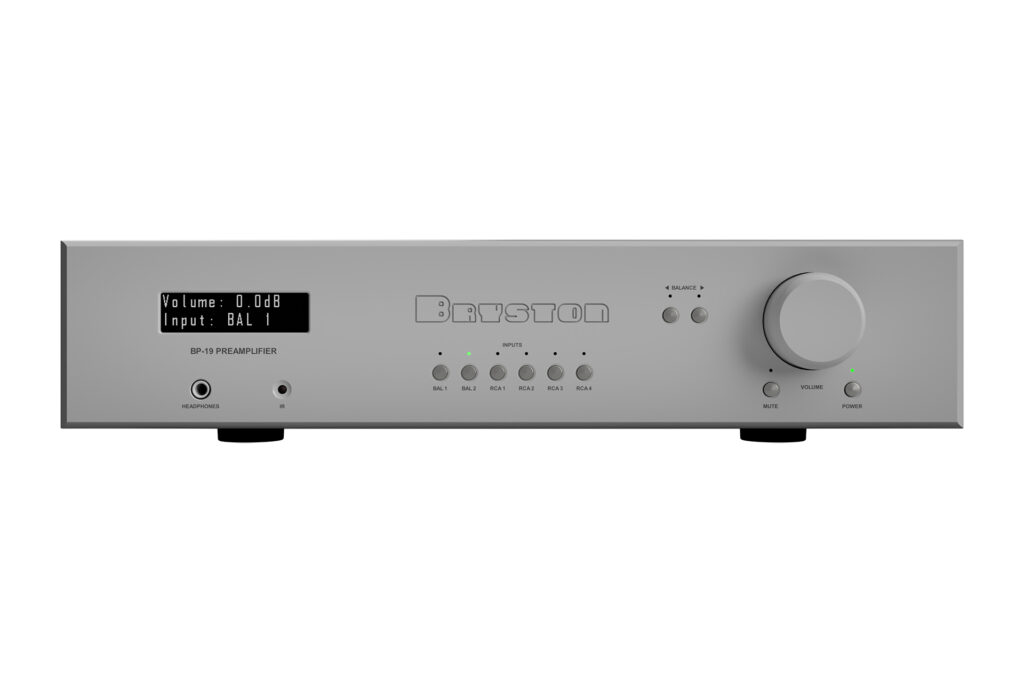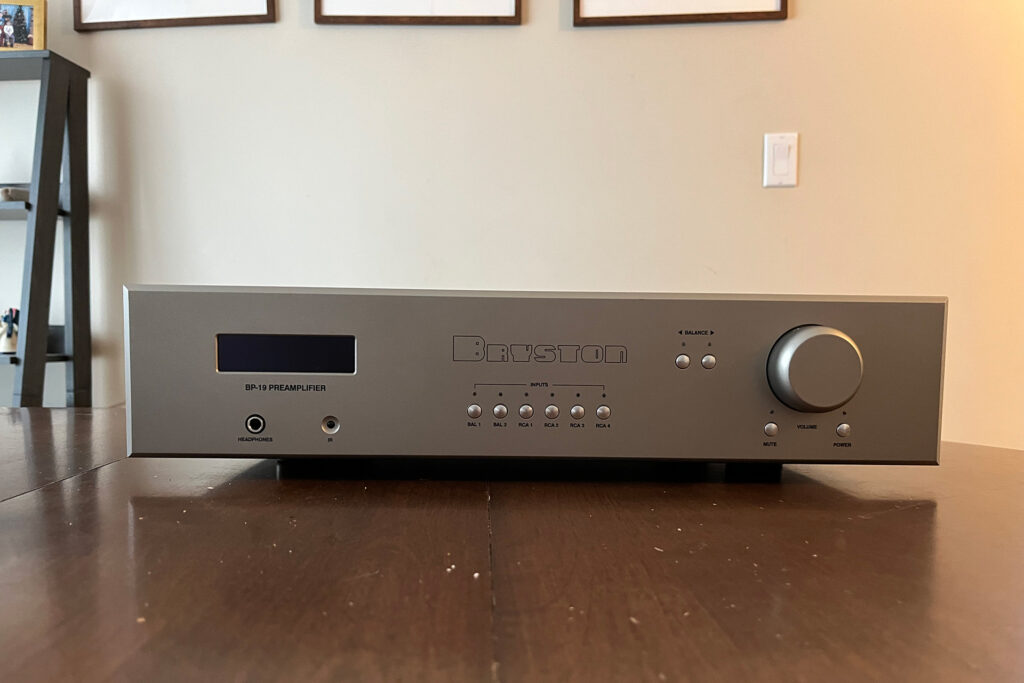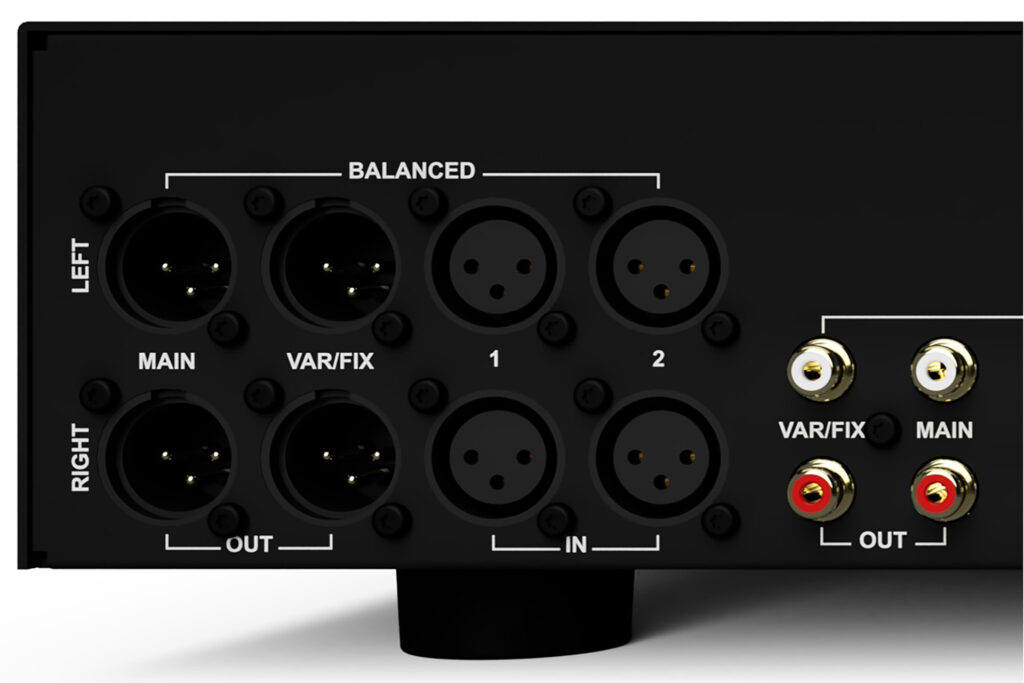Bryston Ltd is a Canadian electronics firm that has been designing and manufacturing consumer and professional audio for the last 35 years, and is based out of the small town of Dwight, Ontario, here in Canada. In their 35 years, Bryston has gained a very good reputation for being incredibly reliable, and they are known for having one of the best warranties in the audiophile world, with their analog products carrying at 20-year warranty. The Bryston BP-19 preamplifier is one of those analog products, and has one of those magnificent warranties. This preamplifier is built with a straightforward approach. It includes two pairs of XLR inputs, two pairs of XLR outputs (they ship in variable mode and one can later be set to fixed output), and four RCA inputs. Let us take a closer look at this preamplifier to see if it is worth its $5,200 price tag.

What Makes the Bryston BP-19 Stereo Preamplifier So Special?
- It is hard to talk about Bryston without talking about the long warranty. As many audiophiles know, part of what you are buying with a Bryston analog product is the warranty, and 20 years is pretty hard to beat.
- The Bryston BP-19 preamplifier was built for use in a professional equipment rack. If you’re someone who keeps their audiophile gear in a rack (think: our publisher), Bryston has built these components for you. The Bryston BP-19 preamplifier is a full 19-inch rack width, and the faceplate is designed to fit racks perfectly.
- The Bryston BP-19 provides a colorless sound. This is exactly what most of us want from our audiophile preamplifier, meaning that it doesn’t impart its sound over the sound of the recording. The Bryston BP-19, through all of my listening, didn’t add any “flavor” to the sound of the music, which is what I consider the hallmark of a quality preamplifier.
- The remote control is fantastic, which is a rare observation from any audiophile reviewer.It isn’t often that I praise the remote for audio gear, but I really liked the one included in the Bryston BP-19. It is well-built, and while you don’t need a lot from a remote for your preamplifier, the volume controls were spot-on. They adjust the volume in five dB increments, and you can change the input and power as well.
Why Should You Care About the Bryston BP-19 Preamplifier?
The audiophile who is most likely to be looking at this preamplifier is a person who really appreciates built quality and wants a studio-grade, neutral sound in his or her system. There isn’t an internal DAC to get outdated. There is the aforementioned ultra-long, ultra-generous warranty. There is the track record of reliability and in-studio performance that has attracted so many audiophiles over the years.

Some Things You Might Not Like About the Bryston BP-19 Preamplifier
- The look of Bryston equipment isn’t for everyone. The visual design of the Bryston BP-19 preamplifier has a very retro industrial design vibe to it. If you’re going to put the BP-19 preamplifier in a rack, I don’t think you will really care about the way the logo is displayed, but if you’re someone who has their audiophile gear visible and you’re looking for something stylish, this might not be the piece for you.
- There are no bells and whistles with the Bryston BP-19 preamplifier. This preamplifier doesn’t come with extra features or hot new additional features like HDMI, room correction, and so on. The Bryston BP-19 doesn’t include an internal DAC or an audiophile phonostage (you can add one as an upgrade, though). There is no room correction or anything else. When we talk about an analog preamplifier, this is exactly what we are talking about.
Listening to the Bryston BP-19 Stereo Preamplifier …
My testing with the Bryston BP-19 preamplifier was with the Music Hall cd25.3 CD player, the Anthem MCA 225 Gen 2 amplifier, a iFi Zen One Signature DAC, and Paradigm Premier 700F floorstanding speakers.
One of the first tracks I listened to was “Connected by Love” (from Compact Disc) from Jack White’s 2018 album Boarding House Reach. This is White’s third solo album, and easily his most experimental. As an artist, he is best known for having a very raw blues style to his playing, and his love for everything analog, from his amplifiers to how he records his music. However, on this album, he experiments extensively with different electronic sounds, many of which are featured on this track. The Bryston BP-19 preamplifier delivers a healthy dose of sonic transparency to this dense track. The track features lots of subtlety from a heavy dose of (recorded) distortion that is worked into the track. Where the Bryston BP-19 preamplifier really shines here is that you are able to clearly hear all of the little electronic effects, where less sonically revealing or transparent stereo preamps simply leave you wanting for more detail and realism.
Another track that I used was “Dead Wishes” (from Compact Disc) from Chris Cornell’s 2015 solo album Higher Truth. This was Cornell’s final album, and in my opinion easily his best solo work. Cornell and his producers mix in the fantastic studio musicians Patrick Warren and Matt Chamberlin, on drums and piano respectively, whose combined credits range from Stevie Nicks to Bonnie Raitt to Bob Dylan. This track can be difficult to reproduce, as it is almost entirely acoustic and nuanced. I found the Bryston BP-19 to be very revealing with this track. However, I realized that there are effects on the guitars closer to the end of the track, as you can hear reverberation that I hadn’t noticed previously. The (electric) acoustic guitars sounded realistic throughout the track, Cornell’s voice was front and center as you would expect, and the percussion that fills in the rest of the track felt realistic. As a person who grew up with a steady diet of Soundgarden, it is always great to hear Cornell sing, and the BP-19 preamplifier ensured that I enjoyed this track immensely.
The last track I used to evaluate the Bryston BP-19 preamplifier was “I Want to be Happy” (from Compact Disc) from self-titled Thelonious Monk/Sonny Rollins album from 1953. This track features two jazz legends’ musical skills, including Rollins’ iconic tenor saxophone and Monk’s signature piano performance. Rollins’ sax sounded open, and it easily filled the space throughout this track, while Monk’s piano sounded accurate, and like it was behind the tenor saxophone. The Bryston BP-19 preamplifier placed the instruments well and it didn’t feel like it added any color to this legacy recording.
Will the Bryston BP-19 Preamplifier Hold Its Value?
Damn right, the Bryston BP-19 will hold it value over time. One of the biggest things that the 20-year warranty does for Bryston equipment is ensure that the resale value will be there when (if?) you are ready to move on to another preamp. I would be surprised if you were not still able to get a significant return on your investment, even 10 years after purchase, as the buyer will still be getting 10 years of warranty, which would still far exceed most audiophile gear on the market. Gear like this has aged well in the past, and I would expect it to age well into the future, as there isn’t any part of it that will become dated over time.

What is the Competition for the Bryston BP-19 Preamplifier?
The SPL Elector stereo preamp ($2,695 – read the review) is an amazing value and has wooed a few notable audiophile reviewers to write a check to own this equally open-sounding and transparent preamp. The professional audio tie-in is worthy of note in this comparison, as SPL got its start as a professional audio company, but now is making waves in the audiophile space. I love the three finish options on the SPL, but the full-width chassis of the Bryston is more appealing in my equipment rack.
The Pass Labs XP-12 ($6,100 – read the review) is another killer audiophile preamp that comes more from the no-frills world. Designer Wayne Colburn doesn’t get the press that amplifier guru Nelson Pass has over the years – but he should. This handmade-in-California stereo preamp is gorgeous to look at, but far better to listen to, as you will hear that in-the-studio level of resolution that is just addictive to many audiophiles.
The NAD Masters Series M66 ($5,500 – review pending) is in many ways the polar opposite of the Bryston BP-19 in terms of feature set. This preamplifier comes with what seems like everything. It has a 32-bit internal DAC, it has room correction, it has streaming built in, a moving coil and moving magnet phono stage all under the hood. You also get multiple digital and analog inputs, as well as balanced inputs and outputs. If you’re shopping in a similar budget, but you really want your preamp to do everything, the NAD might be a good choice.

Final Thoughts on the Bryston BP-19 Stereo Preamplifier …
The thing about Bryson’s audiophile gear is that it has a very specific appeal that can be very strong. I can’t help but to compare the Bryston BP-19 to a Lexus. Your friends likely won’t gawk at the sex appeal or modest feature set of the preamplifier, but the sound (or lack thereof) will never let you down. The other part that really stands out with this preamplifier is that it does the things you need it to do, really well. I wasn’t able to detect any color being added to the music from the preamplifier, and at the heart of what makes a great audiophile preamplifier is that factor alone. Also, the volume knob allows you to adjust the volume by small (one decibel) increments.
For those who appreciate value, build quality and overall sonic transparency, the Bryston BP-19 is a very worthy consideration. The preamp is built to last, doesn’t add any color, and will easily compliment systems with components costing much more in other categories. Other than not being fancy or overly feature-laden, there just isn’t much not to like about the Bryston BP-19 stereo preamp. It does its job, and does it very well, all for a fair price.



